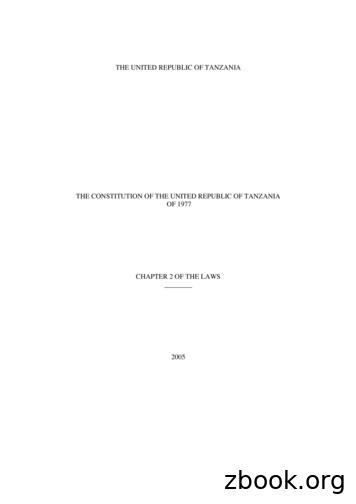TANZANIA REVENUE AUTHORITY
TANZANIA REVENUE AUTHORITYTAX ADMINISTRATION REFORMS INTANZANIA – EXPERIENCE ANDCHALLENGESPresented by Harry M. KitillyaCommissioner GeneralTo the Conference on Revenue Mobilisation in Developing Countries,IMF - Fiscal Affairs DepartmentWashington D.C.April 17-19, 2011TRATANZANIA REVENUE AUTHORITY
SCOPE1.02.0IntroductionTax Administration Reforms(Objectives & Accomplishments)3.04.05.06.0TRAChallenges (Obstacles)Strategies for the FutureKey LessonsConclusionTANZANIA REVENUE AUTHORITY
1.0 INTRODUCTIONTRA was established under TRA Act cap 399and became operational in July 1996 with thefollowing functions:a) Assess, collect & account for Govt Revenueb) Administer revenue lawsc) Advise Govt on fiscal policyd) Promote voluntary tax compliancee) Improve quality of servicef) Counteract Fraud – tax evasiong) Produce trade statistics and publicationsTRATANZANIA REVENUE AUTHORITY
2.0 Tax Administration Reforms.2.1 Revenue CollectionRevenue Collections have increased in absoluteterms from an equivalent of US 1,575 million in2004/05 to US 3,742,million in 2009/10Revenue to GDP ratio has increased from 10.8%in 2004/05 to 14.6% in 2009/10TRATANZANIA REVENUE AUTHORITY
Tax Revenue Trends and Growth 2002/03 – 2010/11(Million TShs)TRATANZANIA REVENUE AUTHORITY
2.0 Tax Administration Reforms.2.2 Integration of TRA operationsLarge Taxpayers in October 2001 Handles 400 taxpayers Contributes 70% of domestic Revenue collectionsVAT and Income Tax Department to form theDomestic Revenue Department in 2005 Handles small and medium taxpayers Contributes 30% of domestic revenueTRATANZANIA REVENUE AUTHORITY
VAT Collection Trends and Growth2002/03 – 2009/10 (Million TShs)TRATANZANIA REVENUE AUTHORITY
2.0Tax Administration Reforms.2.3Review of PAYE Structure – Un-taxableincome by July 2010 is US 98 per month2 4 Payment2.4Pt off TTaxes throughthh BanksB k – 97% offtotal revenue collection is settled underinterbank arrangements; implementation ofTISS2 5 Use of ICT systems for Tax Operations2.5ITAX (includes TIN and e-filing)ASYCUDA Computerised Motor Vehicle Registration SystemComputerised Drivers License SystemTRATANZANIA REVENUE AUTHORITY
2.0Tax Administration Reforms.2.6 Risk Based OperationsEnterprise wide Risk Management SystemRisk Analyses Studies in trade, Manufacturing,construction, telecomm and financial sectorsTRA Data WarehouseIImportt /Export/Et CommodityCdit DatabaseD t bElectronic Fiscal DevicesTRATANZANIA REVENUE AUTHORITY
2.0 Tax Administration Reforms 2.7 Taxpayer Service and EducationStakeholders Forum and Taxpayers’Taxpayers DayTaxpayers’ CharterTaxpayer Centres2.8 Governance and IntegrityInternal Affairs UnitWhistle Blowing; Code of EthicsD l ti off ADeclarationAssetst bby stafft ff2.9 Monitoring of the Corporate Plan throughTRAMEDTRATANZANIA REVENUE AUTHORITY
2.0 Tax Administration Reforms 2 10 Factors Behind Success2.10Management commitment to the reform processGovernment supportFinancial support from the Donor communityPolitical will and supportT h i l assistanceTechnicali tffrom DPDPs especiallyi ll IMFTRATANZANIA REVENUE AUTHORITY
3.0 CHALLENGES.3.1 Tax Administration ChallengesRaising revenue to GDP ratioBroadening the Tax BaseChanging of Staff mindset and Staff IntegrityOver reliance on International Trade TaxesAuditing of Specialised SectorsT EvasionTaxEiTRATANZANIA REVENUE AUTHORITY
Revenue to GDP Ratio in Tanzania2001/02 -2009/102009/10TRATANZANIA REVENUE AUTHORITY
3.0 CHALLENGES3.2 Tax Policy ReformsAddressing Tax Incentives and ExemptionsTanzania has the highest Exemption GDP Ratio in EATRATANZANIA REVENUE AUTHORITY
3.0 CHALLENGES.3.3 External Factor Beyond TRA ControlPower availability and StabilityNational Identity Card (NIDA) – absence ofbio dataPhysical Location of Business EntitiesInternal – Robust Integrated OperationalS tSystemsExternal – Poor ICT BackboneTRATANZANIA REVENUE AUTHORITY
4.0 STRATEGIESReview of VAT StructureEnhancing Audit Capacity in specialised sectorsEstablish International Taxation UnitEnhancing communication andexchange ofinformationImproving classification & ValuationStrategies to minimise tax evasionDevelopment of revenue mobilisation strategyTaxation of the informal sectorBusiness Process Re-engineeringggTRATANZANIA REVENUE AUTHORITY
5.0 KEY LESSONSIntricate act of balancing reforms and increasingrevenue collectionThe process of changing people’s mindset toaccept and join the reforms is tough and enduringParticipatory approach in formulation andimplementation of corporate strategies isimportantContinuous monitoring end evaluation of reformsprovides early warning of failure hence remedialmeasures can be instituted to put the reforms oncourseTRATANZANIA REVENUE AUTHORITY
5.0 CONCLUSIONTRA will continue to implement its core function ofcollecting and accounting of Government revenueTRA is committed to improve domestic resourcemobilisation to enable the Government fulfil itssocial obligationsTRA is determined to make Tanzania selfsufficient in terms of budgetary requirements andreduce external aid dependenceTRA looks forward to benefit from the launchedTopical Trust Funds created in support of IMF’sTechnical Assistance in Tax MattersTRATANZANIA REVENUE AUTHORITY
.Thank yyou for yyour kindattention.TRATANZANIA REVENUE AUTHORITY19
2.0 Tax Administration Reforms. 2.1 Revenue Collection Revenue Collections have increased in absoluteRevenue Collections have increased in absolute terms from an equivalent of US 1,575 million in 2004/05 to US , 3,742 million in 2009/10 Revenue to GDP ratio has increased fromRevenue to GDP ratio has increased from 10.8%
TARP Tanzania Agricultural Research Project TAWIRI Tanzania Wildlife Research Institute TAWLAE Tanzania Association of Women Leaders in Agriculture and Environment TBC Tanzania Broadcasting Cooperation TBS Tanzania Bureau of Standard TCC Tanzania Communications Commission TCCIA Tanzan
education in Tanzania and defines the roles of national and local education bodies. Sources: UNESCO-IBE (2010). World Data on Education VII Ed. 2010/11. United Republic of Tanzania. Geneva: UNESCO-IBE. United Republic of Tanzania (1997). National Council for Technical Education Act. Dodoma: United Republic of Tanzania.
TRA TANZANIA REVENUE AUTHORITY Procedure of processing exemption – cont. A: for imported Goods Importer is required to apply for exemption approval letter to the Commissioner for Customs and Excise attaching along with their application letter, a original Confirmation letter from District
taxation in Tanzania The tax-structure in Tanzania has changed over the years (Table 2.1). The total income-tax-revenue share in GDP was 3.6% in 1999/2000, falling to 3.0% in 2000/01 but rising again to 3.4% in 2002/03. The corporate
THE UNITED REPUBLIC OF TANZANIA THE CONSTITUTION OF THE UNITED REPUBLIC OF TANZANIA OF 1977. CHAPTER 2 OF THE LAWS. 2005 . The following is the official Revised version in English of “KATIBA YA JAMHURI YA MUUNGANO WA TANZANIA YA MWAKA 1977”. This revised edition of the
THE UNITED REPUBLIC OF TANZANIA NATIONAL LAND POLICY MINISTRY OF LANDS AND HUMAN SETILEMENTS DEVELOPMENT DAR ES SALAAM TANZANIA . NATIONAL LAND POLICY The Ministry of Lands and Human Settlements Dar es salaam, Tanzania Second Edition 1997 . CONTENTS PAGE PREFACE ii DEFINITIONS iii
2.1- Tanzania (United Republic of)’s HDI value and rank Tanzania (United Republic of)’s HDI value for 2019 is 0.529— which put the country in the low human development category—positioning it at 163 out of 189 countries and territories. Between 1990 0.529and 2019, Tanzania (United Republic of)’s HDI value increased from 0.368 to , an
Self-medication is prevalent in Tanzania, making the OTC medicine market an attractive prospect. Market Overview Tanzania's pharmaceutical market is among the largest in Sub-Saharan Africa. Tanzania's pharmac























